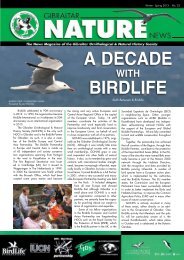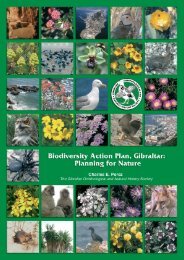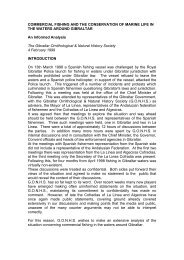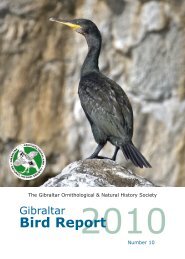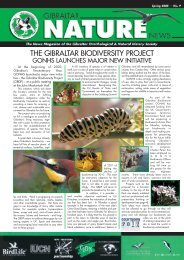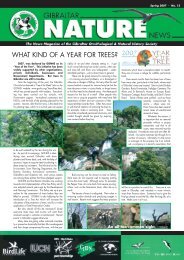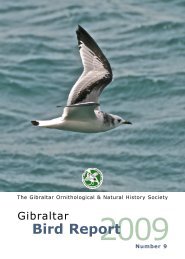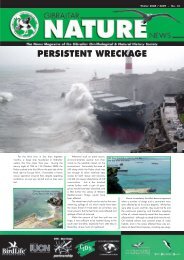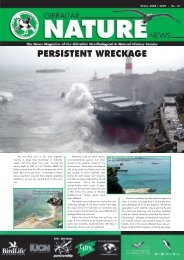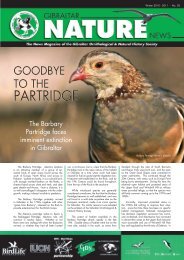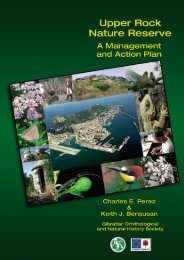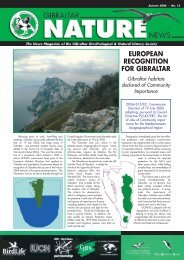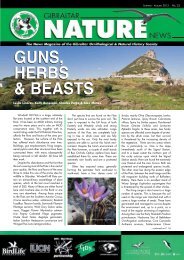No.15 - Gibraltar Ornithological & Natural History Society
No.15 - Gibraltar Ornithological & Natural History Society
No.15 - Gibraltar Ornithological & Natural History Society
You also want an ePaper? Increase the reach of your titles
YUMPU automatically turns print PDFs into web optimized ePapers that Google loves.
calandra), Thekla Larks (Galerida theklae) and<br />
Calandra Larks (Melanocorypha calanda) are<br />
all numerous and their calls and songs are<br />
loud and distinctive. Tawny Pipits (Anthus<br />
campestris) and Yellow Wagtails (Motacilla<br />
flava iberiae) also breed, as do small numbers<br />
of Black-eared Wheatears (Oenanthe oenanthe)<br />
and Woodchat Shrikes (Lanius senator).<br />
Melodious Warblers (Hippolais polyglotta) and<br />
Nightingales (Luscinia megarrhynchos) move in<br />
during the spring from their African wintering<br />
grounds to breed in thicker vegetation<br />
bordering streams. A permanent feature of<br />
the Santuario are the Griffon Vultures (Gyps<br />
fulvus) which circle slowly over these fields in<br />
search of carrion, breeding on crags and cliffs<br />
in the nearby hills. A dead calf or cow will<br />
sometimes attract two or three hundred<br />
vultures. Occasionally, these are joined by<br />
one or two Black or Cinereous Vultures<br />
(Aegypius monachus) wintering in the area or<br />
Santuario landscape<br />
on passage, as well as Rüppell’s Vultures<br />
(Gyps rueppelli), a sub-Saharan species that<br />
has become regular in the Strait area. Flocks<br />
of Lesser Kestrels (Falco naumanni) can also be<br />
seen flying and hovering over these fields,<br />
which are part of the foraging grounds of the<br />
colony that breeds in the old walls at Tarifa.<br />
The Santuario is not just important for<br />
migrating and nesting birds. The area is rich<br />
in invertebrates. It has a very diverse and<br />
interesting fauna of ground beetles (family<br />
Carabidae) and is one of the sites where<br />
Anochetus ghilianii, an ant species that is<br />
almost endemic to the area of the Strait, can<br />
be found. The richness in large invertebrates<br />
and nesting birds makes the site ideal for the<br />
Mandragora autumnalis<br />
Nightingale<br />
largest lizard in Europe, the Ocellated Lizard<br />
(Timon lepidus). Individuals can frequently be<br />
seen sitting on rocks during the spring and<br />
summer months, basking in the sun. Once<br />
alerted to the presence of humans or predators,<br />
they very quickly slip under the large rocks on<br />
which they sit. Short-toed Eagles (Circaetus<br />
gallicus), which feed mainly on reptiles (earning<br />
them the alternative name of Snake Eagle)<br />
frequently hawk over the fields at the Santuario<br />
and include Ocellated Lizards among their<br />
prey. These birds of prey nest on trees in the<br />
hills that surround the Santuario.<br />
Much of the countryside surrounding Tarifa<br />
remains unprotected. This is unfortunate given<br />
that most of it is important for wildlife, most<br />
particularly birds. The<br />
hundreds of wind turbines<br />
that line hilltops certainly<br />
pose a hazard to birds of<br />
prey, migrant and resident.<br />
However, a much more<br />
serious threat is posed by<br />
recurring plans for<br />
development of parts of<br />
this countryside, most<br />
notable some of the fields<br />
of the Santuario de la Luz.<br />
notes & neWs<br />
the ruBBLe mountAin<br />
A botanical survey of the rubble mountain between<br />
Eastern Beach and Catalan Bay was carried out on<br />
13th May this year. Despite the composition of the<br />
mound which contains all sorts of construction<br />
material and rubbish of all descriptions, the whole<br />
site was ablaze with colour from the flowers growing<br />
on it. A total of 111 species were recorded on<br />
the site, including a number of <strong>Gibraltar</strong> candytuft,<br />
Iberis gibraltarica; wild parsley, Petroselinum<br />
crispum; and Succowia balearica, all of which are<br />
protected under Schedule 3 of the Nature Protection<br />
Act 1991! Other interesting species found here<br />
were a large number of white buttons, Anacyclus<br />
clavatus, a rare species on the rock; a single plant<br />
of the rare small-flowered bugloss, Echium parviflorum;<br />
a small stand of the Italian sainfoin, Hedysarum<br />
coronarium, which is otherwise only found on<br />
Windmill Hill Flats; and a couple of castor oil<br />
plants, Ricinus communis, which are rare on the<br />
Rock.<br />
If the mound is not removed soon, it could well<br />
become a protected habitat!!!<br />
toiLets for the uPPer rocK<br />
The Tourist Board is in the process of constructing<br />
much needed public toilets in the Upper Rock<br />
Nature Reserve. One of these will be situated by the<br />
Moorish Castle ticket office and another by the car<br />
park at the bottom of the hill leading to The Great<br />
Siege Tunnels. In connection with these works, new<br />
sewage pipes have had to be laid from the car park<br />
all the way down to Hay’s Level and on to the<br />
Moorish Castle ticket office.<br />
Representatives from GONHS attended to a site<br />
meeting at Moorish Castle to discuss the environmental<br />
impact of the construction at this site. The<br />
structure will result in the loss of habitat in the form<br />
of a clearing, which contained a community of<br />
fairly common species of plants, including the giant<br />
Tangier fennel, Ferula tingitana. This species is in<br />
Schedule 3 of the Nature Protection Act, and therefore<br />
a protected species and their removal will<br />
require a licence. In compensation for this loss of<br />
habitat, the representatives from the Tourist Board<br />
agreed to re-locate plants to the slopes below the<br />
ticket office where the habitat can be re-constructed.<br />
No such consultation was held with respect to the<br />
other toilet site. Here the first GONHS heard of<br />
these works was when the contractors were already<br />
digging away at the site. A site meeting was<br />
requested and at this meeting it was discovered that<br />
there were plans to lay the pipe in a trench to be<br />
dug along the top of the ancient wall which runs<br />
down Willis’s Road from Princess Caroline’s Battery<br />
to the Lime Kiln. GONHS presented strong objections<br />
to any tampering with this wall, especially<br />
since there are protected species growing on it, in<br />
particular three stands of the rare brown bee<br />
orchid, Ophrys fusca, and one stand of the <strong>Gibraltar</strong><br />
saxifrage, Saxifraga globulifera subsp gibraltarica.<br />
Following our representations, it was decided that<br />
the trench would be dug along the road itself and<br />
the wall left untouched. However, as can be seen<br />
on the photos, not much care was taken to respect<br />
the wall. Barriers, pipes, and even diesel oil containers<br />
can be seen littering the top of the wall!<br />
GIBRALTAR NATURE NEWS<br />
11



